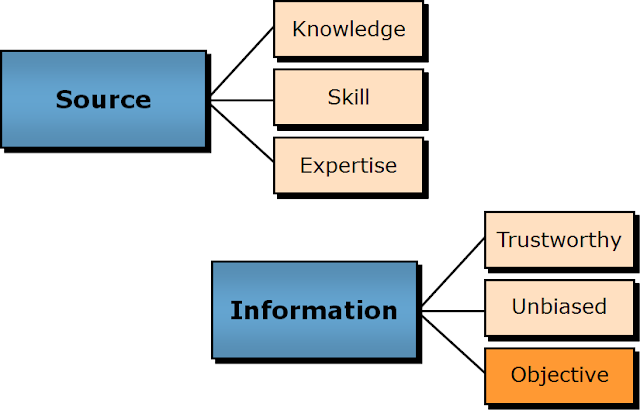The Persuasion Matrix
The persuasion matrix helps marketers to see how each controllable element of the communication process interacts with the consumer’s response process. The matrix has two sets of variables.
Independent variables are the controllable components of the communication process while dependent variables are the steps a receiver goes through in being persuaded. The numbers in the cells represent decisions that can be evaluated using the persuasion matrix that are discussed in the next slide.
Promotional Planning Elements
This above diagram presents specific decisions that correspond to the numbers in the cells of the persuasion matrix that were presented earlier. These include:
- Receiver/comprehension – can the receiver comprehend the ad? Consideration must be given to whether the target audience can understand and comprehend a message.
- Channel/presentation – which media will increase presentation? How effective is a particular media vehicle in reaching the target audience?
- Message/yielding – what type of message will create favorable attitudes or feelings? Marketers try to create messages that will lead to positive feelings toward the product.
- Source/attention – who will be effective in getting consumers’ attention? Marketers select sources that will be effective in gaining the attention of the target audience such as celebrities, athletes, or attractive models.
Source Attributes and Receiver Processing Modes
The three basic source attributes and processing modes associated with each are as follows:
- Credibility – the extent to which the recipient sees the source as having relevant knowledge skill or experience and trusts the source to give unbiased, objective information.
- Internalization – the process by which a receiver adopts the position advocated by the source because it is perceived as accurate and makes it part of his or her belief system
- Attractiveness – refers to the similarity, familiarity, and/or likeability of the source
- Identification – the process by which an individual is motivated to seek some type of relationship with the source and thus adopts similar beliefs, attitudes, or behaviors.
- Power – refers to the ability (real or perceived) of the source to administer rewards or punishment to the receiver
- Compliance – the process by which the receiver accepts the position advocated by the source to receive rewards or avoid punishment
Source Credibility
There are two important dimensions to source credibility, expertise and trustworthiness. Marketers recognize that expertise is extremely important and choose spokespersons who have knowledge, skill, or experience with a particular product or in a service area. Endorsements from individuals or groups recognized as experts, such as doctors or dentists are common in advertising. While expertise is important, the target audience must find the source believable. Trustworthiness relates to the source’s objectivity, honesty, and believability.
Source Attractiveness
The various components of source attractiveness include similarity, familiarity, and likeability.
A brief of each characteristic follows:
- Similarity - resemblance between the source and the recipient of the message. Marketers recognize that people are more likely to be influenced by a message coming from someone with whom they feel a sense of similarity (e.g. similar needs, goals, interests, lifestyles).
- Familiarity – knowledge of the source through exposure. Familiarity is enhanced through repeated or prolonged exposure.
- Likeability – affection for the source as a result of physical appearance, behavior, or other personal traits. Consumers can admire physical appearance, talent, and/or personality even if the source is not well known or a celebrity.
Risks of Using Celebrities
Although celebrities can be effective in gaining attention and influencing consumers, there are some factors that must be considered before deciding to use them.
These are:
- Overshadowing the product – advertisers should select a celebrity spokesperson who will attract attention and enhance the sales message, but not overshadow the brand.
- Overexposure – consumers can become skeptical when a celebrity endorses too many products or companies and becomes overexposed.
- Target audiences’ receptivity – it is important for marketers to select a celebrity endorser who matches and is well received by the advertiser’s target audience.
- Risk to the advertiser – the advertiser needs to select an endorser who will not embarrass the company. Researching the celebrity’s personal life and background to reduce this risk is becoming common.
Meaning Movement and the Endorsement Process
The meaning movement and endorsement model illustrates why celebrity endorsements are effective. It is based on the premise that credibility and attractiveness do not sufficiently explain how and why celebrity endorsements work. According to the model, a celebrity’s effectiveness as an endorser depends on the culturally acquired meanings he or she brings to the endorsement process.
There are three stages of meaning movement:
- Stage 1 – celebrities draw these meanings from the roles they assume in their television, movie, military, athletic, and other careers. Each new dramatic role brings the celebrity into contact with a range of objects, persons, and contexts.
- Stage 2 – celebrities bring their meanings and image into the ad and transfer them to the product they are endorsing.
- Stage 3 – the meanings the celebrity has given to the product are transferred to the consumer.
Source Power
Source power depends on several factors. The source must be perceived as being able to administer positive or negative sanctions to the receiver (perceived control) and the receiver must think the source cares about whether or not the receiver conforms (perceived concern). The receiver’s estimate of the source’s ability to observe conformity is also important (perceived scrutiny).
Recall and Presentation Order
Message structure is very important to overall communication effectiveness. A basic consideration in the design of a persuasive message is the order of presentation of message arguments. Research on learning and memory generally indicate that items presented first and last are remembered better than those presented in the middle. This chart shows that the strongest arguments should be placed at the beginning or end of the message, but not in the middle.
Message Appeal Choices
One of the advertiser’s most important creative strategy decisions involves the choice of an appropriate appeal.
There are two broad categories of message appeals:
- Rational – focus on consumer’s practical, functional, or utilitarian needs
- Emotional – focus on consumer’s social and/or psychological needs or feelings
Many believe that the most effective advertising combines the practical reasons for purchasing a product with emotional values.
Message Appeal Options
There exists various advertising message appeal options that can be used in an advertising message. These include:
1. Comparative Ads – directly or indirectly naming competitors in an ad and comparing one or more specific attributes.
Characteristics of comparative advertising include:
- FTC advocated this type of advertising in 1972 to give consumers a more rational basis for making purchase decisions.
- Useful for new brands to get in the evoked set of the consumer
- Often used for brands with small market share
- Used frequently for political advertising
2. Fear appeals – evokes an emotional response of danger and arouses individuals to take steps to remove the threat.
Characteristics of fear appeals include:
- May stress physical danger (drugs) or social rejection (mouthwash)
- Have both facilitating and inhibiting effects
Characteristics of humorous appeals include:
- An effective way to attract and hold attention
- Put consumer in positive mood
- Can wear out once the receiver get the joke or punch line
Fear Appeals and Message Acceptance
The above chart depicts the relationship between fear levels and message acceptance. This chart suggests the relationship between the level of fear in a message and acceptance or persuasion is curvilinear. This means that message acceptance increases as the amount of fear used rises, but only to a point. Beyond that point, acceptance decreases as the level of fear rises. The relationship between fear and persuasion can be explained by the fact that fear appeals have both facilitating and inhibiting effects.
Low levels of fear can have facilitating effects which attracts attention and interest in the message and may motivate the receiver to act to resolve the threat. Thus increasing the fear from low to moderate can result in increased persuasion.
High levels of fear, however, can produce inhibiting effects whereby the receiver may emotionally block the message by tuning it out, perceiving it selectively or denying the arguments outright.
Pros and Cons of Using Humor
Although, humorous ads are some of the best known and most memorable of all advertising messages, not every product or every marketing situation lends itself to humor. Advertisers should consider these pros/cons in their decisions regarding the use of humor to attract attention and gain awareness for their products.
Self versus External Paced Media
The final controllable variable of the communications process is the channel or medium used to deliver the message to the target audience. There are basic differences in the manner and rate at which information from various forms of media is transmitted and can be processed.
The two broad classifications of media are:
- Self-paced – readers/viewers process the ad at their own rate. Self-paced media include print media such as newspapers, magazines, and direct mail as well as the Internet.
- Externally-paced – the transmission rate is controlled by the medium. Externally- paced media include radio and television.



















































